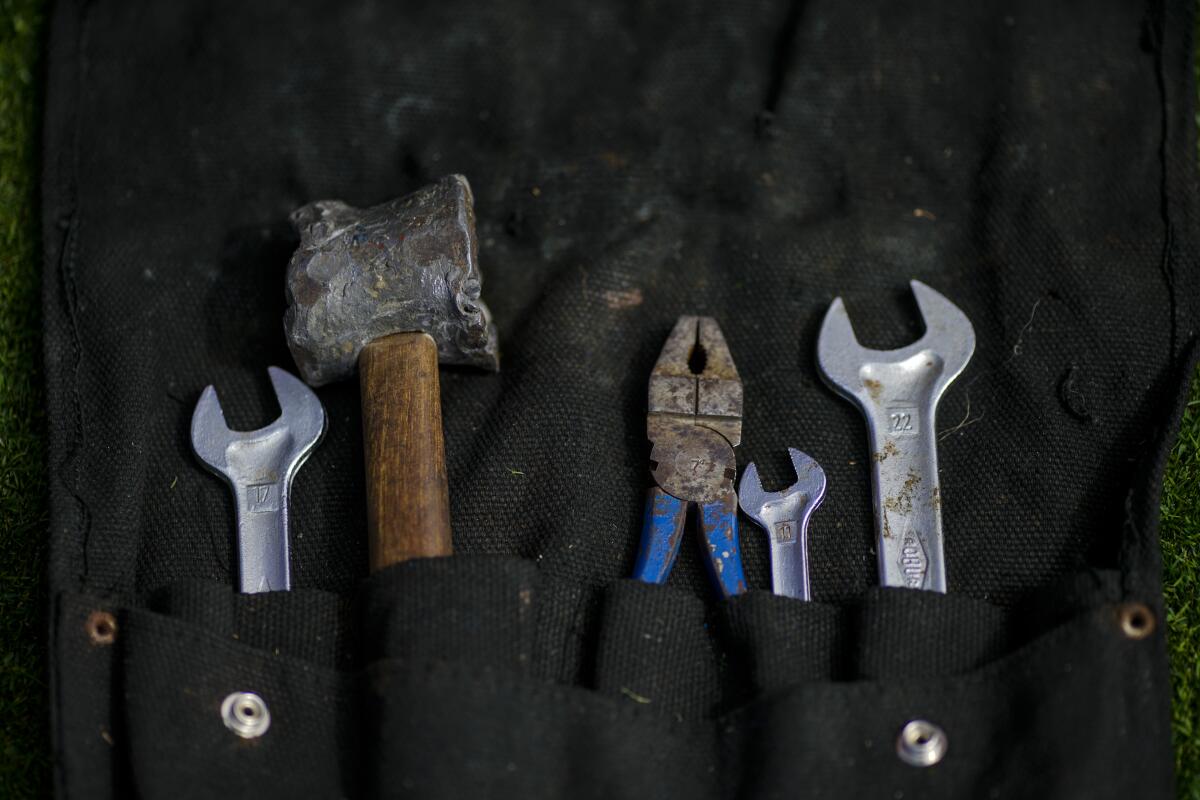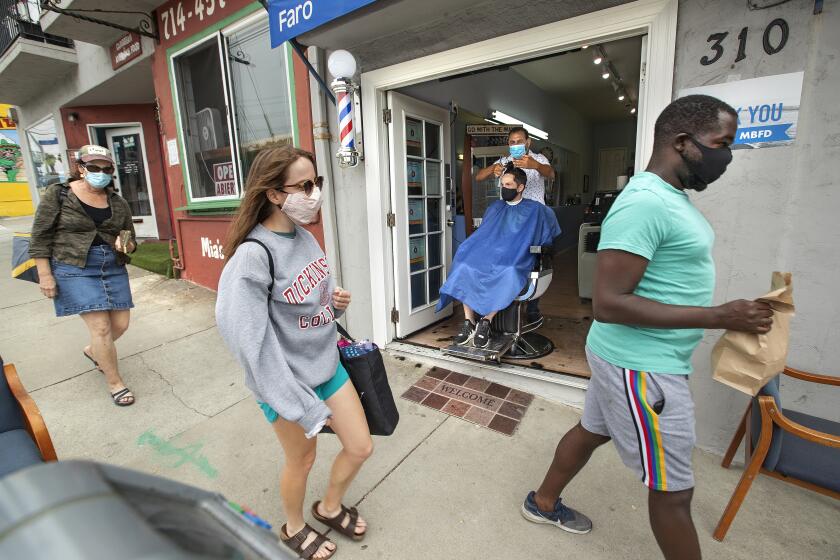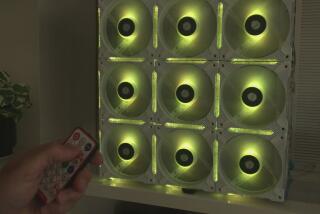Should you fix that yourself? How to handle home repair during the pandemic

- Share via
When Tony Nittoli of North Hollywood noticed a leak under his bathroom sink in mid-April, he tied it up with an old T-shirt and stuffed junk mail under it. He’d normally call his apartment manager to take care of it, but health officials’ orders were clear: stay inside and away from others to slow the spread of the coronavirus.
“What’s the sense of me not going out if I have somebody who’s going out to multiple houses coming to my house?” Nittoli said. “That defeats the purpose.”
Plumbers, electricians and handymen and -women are considered essential workers during the COVID-19 crisis. They’ve continued to come to the rescue when a pipe bursts or the electricity goes haywire. It’s frequently hazardous work, pandemic notwithstanding.
But what about when it’s not life or death, but life and discomfort? If the washing machine won’t wash or the screen door won’t seamlessly slide, does it make sense to call a professional? Does bringing in a worker — or several — put your safety and theirs at risk? Do you try doing it yourself? Is fixing a sink as easy as baking bread?
If beaches and businesses are reopening, does that mean I can visit my friends and family now? The new rules on socializing during social distancing.
Safety first
Although home-repair workers were never ordered to put away their tools, business practices have shifted to meet the moment, according to several industry stakeholders.
Workers are required to wear masks and keep their distance from others inside a home, apartment or commercial space they’re working in, just as in other essential businesses, according to public health guidelines. Some companies outfit their workers in additional protective gear, such as gloves and booties.
For Mike Rios, who owns and manages seven rental units in West L.A., the adjustment hasn’t been hard.
His go-to handyman “wears a mask and [it’s] business as usual,” he said.
Talieh Safadi, owner of Help Squad, a repair company with a location in Brentwood, said he typically asks customers to take a walk while work is being done or stay in another room.
Tom Bannon, chief executive of the California Apartments Assn., which represents the rental housing interests, agreed that safety protocols are a two-way street.
Repair workers are asked to follow CDC guidelines, “And you hope that that the residents can do the same,” Bannon said.
The significant increase in the city’s coronavirus mandates is necessary to help slow the spread of COVID-19, Mayor Eric Garcetti says.
When should I call a professional?
If it’s an emergency or serious issue, make the call.
Some repairs simply can’t be put off. An untreated electrical shortage could spark a fire. A leaky pipe in one apartment could cause thousands of dollars of water damage in the entire complex. In those situations, it’s necessary to bring in a trained professional, ideally before a situation grows dire.
If it’s less urgent, weigh the risks.
If you’re a family of five and your washing machine breaks, it might not be feasible to transition to a washboard.
If it’s not urgent, Safadi recommends people over 65 or with underlying health conditions postpone work for a few weeks. If they need to go forward with a repair, he advises increasing safety precautions.
Apartment owners still have an obligation to make repairs within a reasonable time frame, but Bannon stressed that the pandemic has affected what’s reasonable.
Some tenants don’t want home-repair workers in their units — and it’s difficult from a legal perspective for a landlord to enter a unit against their wishes, Bannon said. On the flip side, some maintenance workers are hesitant to put themselves at unnecessary risk. The latter makes it trickier to find someone to tackle a job immediately and increases the turnaround time for some repairs, he added.
“It’s not a good time for maintenance unless it’s a serious issue,” Bannon said.
To contain the spread of COVID-19, parks, restaurants and stores are slowly reopening.
Repair needs are increasing
People in the industry agree that comfort levels around home repair appear to be rising — possibly out of necessity.
According to ServiceTitan, a tech company that develops software for home-services workers, revenue for contractors in California in the first two weeks of May jumped 10% over the same period last year. And the numbers are showing improvement nationally.
Calls never stopped completely for contractor Edward Flanagan, though they did fall significantly after California’s stay-at-home order went into place. He estimates that he’s getting half as much business as usual now, compared with a quarter as much in mid-March.
Many of the large residential projects Safadi had lined up, including a more than $100,000 job to convert a garage to a living space, are on hold. But he said he is fielding more quotidian requests, including calls about broken dishwashers, toilets, garbage disposals, doors and faucets. More time at home means more wear and tear.
“Remember, all of us were home, including me and my wife, on lockdown,” Safadi said. “And guess what? There were a lot more issues with maintenance because everybody’s home.”
Trying to get a handle on how California is reopening and what it means for you? Our guide includes updates and tips for remaining healthy and sane.
Should I try to do it myself?
Those concerned about exposure to the virus or who are tight on funds might be considering a DIY approach. Professionals urge caution.
Most plumbing and electrical work, for example, is best left to the professionals.
“One mistake can cause a lot more damage,” Safadi said.
“If you don’t know how to snake a pipe or a garbage disposal, it might leak overnight,” he explained. In a multi-unit complex, that can get expensive: “Because it leaks into the unit below or the unit next door and then it becomes a huge thing.”
Besides property damage, “there’s potential damage you could do to yourself,” Bannon said, pointing to garbage disposals as one source of danger.
But home maintenance falls on a spectrum of difficulty, said Bob Burke, chief executive of Repair Clinic, a company that offers step-by-step repair tutorials.
“What we’re seeing is that people have real needs, partly caused by the pandemic, partly because things are breaking because they’re at home, and I think people now are realizing they can do a lot more than they might have thought,” Burke said. “People are learning to be creative.”
The service is starting to see engagement with a younger audience, particularly in the 22 to 35 age range, according to Peter Krauss, president of the company. Their typical customer had been 45 or older, he said.
Marnie Sehayek initially intended to pay a handy friend to build out a closet in her Koreatown apartment. When L.A. issued its safter-at-home order in mid-March, that no longer seemed wise. Instead, she watched videos, conferred with friends, borrowed tools from a neighbor and did it herself over the course of several weeks.
“To be honest, I felt like I was in a Marx Brothers skit at almost every pass with it,” she said, adding that it ultimately came together. “It’s not exactly perfect, but it totally works for me.”
Then there are the basics, like how to flip a breaker on and off, and where the main water shutoff is, things Flanagan said everyone should know. Otherwise, you could be wasting water and electricity, he said.
“I think it’s good for people to have more of a knowledge of that going on,” he said, “and maybe this will give us a chance for people to do that.”
More to Read
Inside the business of entertainment
The Wide Shot brings you news, analysis and insights on everything from streaming wars to production — and what it all means for the future.
You may occasionally receive promotional content from the Los Angeles Times.















